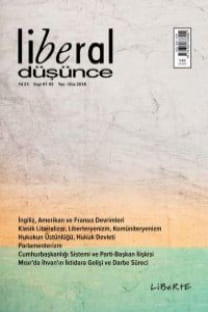Irkçılığın Avrupa’daki Gelişimi ve Uluslararası Hukuka Etkisi: James Lorımer Örneğİ
Irkçılık, Kültürel Irkçılık, Avrupa Merkezcilik, Uluslararası Hukuk, James Lorimer
Development of Racism in Europe and Its Effect on International Law: The Case of James Lorimer
Racism, Cultural Racism, Eurocentrism, International Law, James Lorimer.,
___
- Alver, F. (2003). Basında Yabancı Tasarımı ve Yabancı Düşmanlığı. İstanbul: Der Yayınları.
- Bauman, Z. (1997). Modernite ve Holocaust. (çev. Süha Sertabiboğlu). İstanbul: Sarmal Yayınevi.
- Bernasconi, R. (2014). Where is Xenophobia in the Fight Against Racism?. Critical Philosophy of Race, 2 (1), 5-19.
- Canatan, K. (1990). Göçmenlerin Kimlik Arayışı: Konuk İşçilikten Yerleşik Göçmenliğe. İstanbul: Endülüs Yayınları.
- Chukwuokolo, J. (2010). Afrocentrism or Eurocentrism: The Dilemma of African Development. OGIRISI: A New Journal of African Studies, 6, 24-39.
- De Master, S. ve Le Roy, M. K. (2000). Xenophobia and the European Union. Comparative Politics, 32 (4), 419-436.
- Dirlik, A. (1999). Is There History After Eurocentrism? Globalism, Postcolonialism, and the Disavowal of History. Cultural Critique, (42), 1-34.
- Hammond, R. A. ve Axelrod. R. (2006). The Evolution of Ethnocentrism. The Journal of Conflict Resolution, 50 (6), 926-936.
- Higgins, A. P. (1993). James Lorimer (1818-1890). Juridical Review, 45 (3), 239-256.
- Kallis, A. (2013). Far-Right “Contagion” or a Failing “Mainstream”? How Dangerous Ideas Cross Borders and Blur Boundaries. Democracy and Security, 9 (3), 221-246.
- Knop, K. (2016). Lorimer’s Private Citizens of the World. The European Journal of International Law, 27 (2), 447-475.
- Kohut, A. ve Wike, R. (2008). Xenophobia on the Continent. The National Interest, (98), 46-52.
- Koskenniemi, M. (2016). Race, Hierarchy and International Law: Lorimer’s Legal Science. The European Journal of International Law, 27 (2), 415-429.
- Lorimer, J. (1883). The Institutes of the Law of Nations: A Treatise of the Jural Relations of Separate Political Communities-Vol. I. Edinburgh ve Londra: William Blackwood and Sons.
- Maeso, S. R. ve Araújo, M. (2017). The (Im)plausibility of Racism in Europe: Policy Frameworks on Discrimination and Intergration. Patterns of Prejudice, 51 (1), 26-50.
- Neff, S. C. (2016). Heresy in Action: James Lorimer’s Dissident Views on War and Neutrality. The European Journal of International Law, 27 (2), 477-492.
- O’Donoghue, A. (2018). ‘The Admixture of Feminine Weakness and Susceptibility’: Gendered Personifications of the State in International Law. Melbourne Journal of International Law, 19 (1), 1-32.
- Özbek, S. (2012). Irkçılık. İstanbul: Notos Kitap.
- Özer, Y. Y. (2007). Immigrants and Xenophobia in the European Union (Yayınlanmamış Doktora Tezi). İstanbul: Marmara University Instute of European Studies.
- Poliakov, L. (2011). Arî Miti: Avrupa’da Irkçı ve Milliyetçi Fikirlerin Tarihi. (çev. Yakup Kaya ve Ahmet Yıldırım). Ankara: Epos Yayınları.
- Rydgren, J. (2003). Meso-Level Reasons for Racism and Xenophobia: Some Converging and Diverging Effects of Radical Right Populism in France and Sweden. European Journal of Social Theory, 6 (1), 45-68.
- Shore, C. (1996/97). Ethnicity, Xenophobia and the Boundaries of Europe. International Journal on Minority and Group Rights, 4 (3/4), 247-262.
- Simpson, G. (2016). James Lorimer and the Character of Sovereigns: The Institutes as 21st Century Treatise. The European Journal of International Law. 27 (2), 431-446.
- Stolcke, V. (1999). New Rhetorics of Exclusion in Europe. International Social Science Journal, 51 (159), 25-35.
- Taş, M. (1999). Avrupa’da Irkçılık: Göçmenler ve Aşırı Sağ Partiler. Ankara: İmge Kitabevi.
- Van der Valk, I. (2003). Racism, A Threat to Global Peace. International Journal of Peace Studies, 8 (2), 45-66.
- Vorster, J. M. (2002). Racism, Xenophobia and Human Rights. The Ecumenical Review, 54 (3), 296-312.
- Yakushko, O. (2009). Xenophobia: Understanding the Roots and Consequences of Negative Attitudes Toward Immigrants. The Counseling Psychologist, 31 (1), 36-66.
- ISSN: 1300-8781
- Başlangıç: 1996
- Yayıncı: Liberte Yayınları
Nicolai Hartmann’ın Yeni Ontoloji Perspektifinden Ahlâkî Özgürlük Yorumu ve Kant Eleştirisi
Barış Çalışmalarında Sosyal Temsiller Kuramı: Gruplararası Farklılıklar ve Bağlamsal Etkiler
Organizasyonel Sessizlik, Düşüş ve Ölüm
Farabi’den İbn Haldun’a: Erken Dönem Müslüman Entelektüellerin Yazılarında Devlet Algısı
Bir Türk Siyaseti Okuma Biçimi Olarak Gelenekçi Yaklaşım
Fikri Mülkiyetin Ürün İnovasyonu ve Pazar Şekillenmesi Üzerindeki Yıkıcı Etkileri
Irkçılığın Avrupa’daki Gelişimi ve Uluslararası Hukuka Etkisi: James Lorımer Örneğİ
